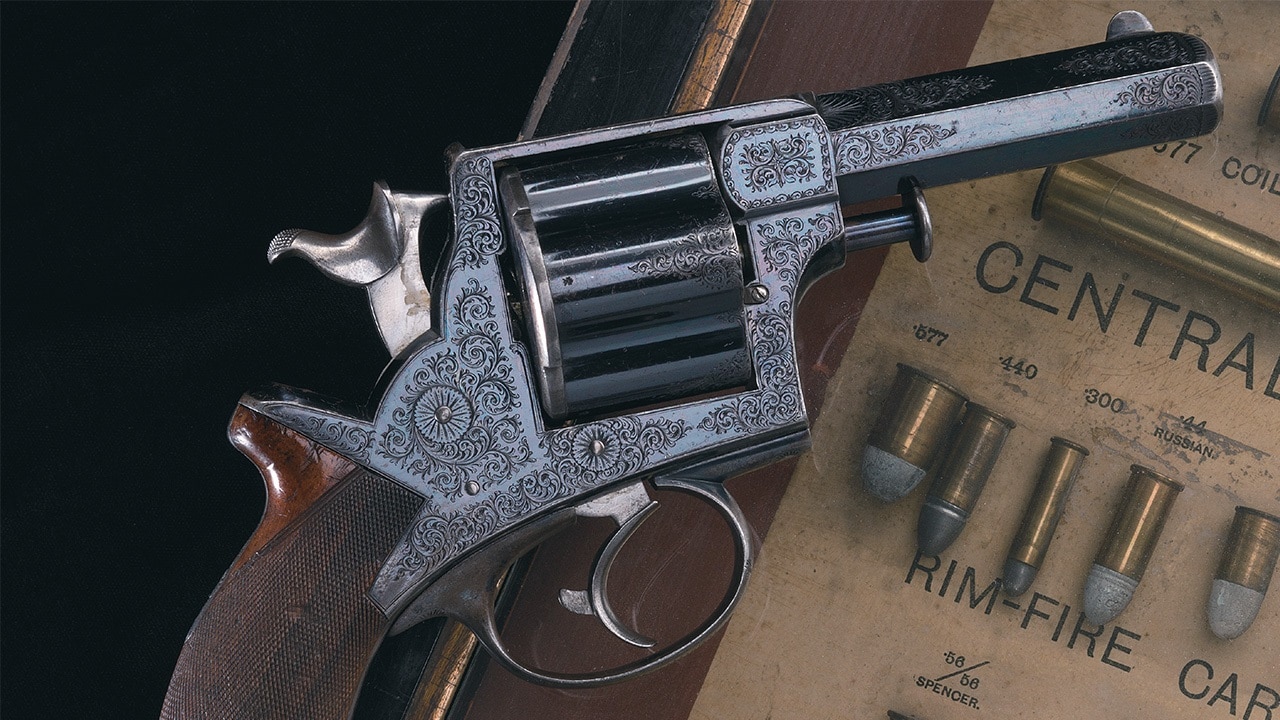When one thinks of large caliber handguns, the Desert Eagle single-action (SA) semiautomatic pistol in .50 Action Express (AE) and the Smith & Wesson (S&W) Model 500 double-action (DA) revolver in .500 S&W Magnum might come to mind. Those are among the most common. However, the British Army has a history of big-bore handguns that give those popular models a run for their money.
In 1988 Guns & Ammo Magazine ran an article about .577 caliber revolvers produced for the Victorian-era British Army, back in the day when the saying “the sun never sets on the British Empire” rang very true.”
So, Why So Goshdarn Big Anyway?
Naturally, some may wonder why the Brits felt compelled to build handguns that bloody big in the first place? Hamilton Bowen, in an article for American Handgunner Magazine titled “BRITISH BIG BORES .577 REVOLVERS,” explains:
“With the exception of the huge Dragoon and Walker Colts, percussion revolvers were typically anemic performers by today’s standards. Even the .44 1860 Army model, perhaps the most widely made and distributed of the Colt percussion revolvers, offered mediocre ballistic performance. The 148 grain conical ball ambling along at a stately 800 fps sounds suspiciously like the .38 Special round-nose factory load which nobody has ever accused of superior man-stopping prowess. Yes, you could kill somebody deader than a hammer with one, but not always right now.
“Many a brave officer in the Queen’s service discovered this the hard way after emptying his token side arm to no effect, then getting gigged in the guts or sliced from crown to crotch. Didn’t take much of this for the brighter members of the officer corps to understand more stopping power was in order.”
This sounds not entirely unlike the U.S. Army’s experience at the turn of the century with the stopping failures of the .38 Long Colt revolver cartridge against the Moro warriors that eventually led to the creation and adoption of the .45 ACP autopistol and cartridge. Meanwhile, the ballistic solution for the Brits, in the era of black power cartridges, was a drawn brass cartridge case hurling a 400-gr. bullet at a muzzle velocity of 725 fps — and was by all accounts an effective manstopper.
To compare, the .500 S&W Magnum loadings start off with a 300-grain bullet and a muzzle velocity of 2,075 feet per second; meanwhile, the .50 AE starts out with a 300-grainer at 1,450 fps.
Gun Specifications
Now that the missile problem was solved, what about the gun to serve as its launching platform? The exact technical specifications are scant, but apparently, four different gunmakers were tasked with building the revolvers chambered for the .577 round. Webley, Braendelin, Tipping & Lawden, and William Tranter.
The Tranter “Manstopper” DA revolver in particular is known to have had a 4.375-inch barrel, as noted by the Rock Island Auction Company, who sold one back in June 2020 for the princely sum of $34,500.00. However, RIAC doesn’t bother to provide figures such as weight or overall length, and neither do any of the sources available during the research conducted for this article. It is known that Mr. Tranter was quite a respected gunmaker in his time; he apprenticed to a gunsmith in 1830, at the age of 14, opened his own gun shop in 1839, began designing, patenting, and producing his own firearms in 1853, and became a founding member of BSA (Birmingham Small Arms).
Webley, in the meantime, is quite famous for its .455 Webley Man Stopper and the Webley Green revolver used by the titular hero in “Indiana Jones and the Last Crusade.”
Modern Equivalents? Want Your Own?
The aforementioned Mr. Bowen took a modern-day Ruger Redhawk .44 Magnum DA revolver and customized it and re-bored it in order to accommodate the bigger cartridges. The reliability of a Ruger is well known, therefore the Redhawk was a logical choice for this ambitious project.
After some tinkering, Mr. Bowen and his crew were able to get 2-inch five-shot groups at 20 yards, and moreover, “The .577 Redhawk has performed flawlessly to date. Thanks to the weight reduction afforded by .577 chambers and bore, handling is light and quick. Recoil is substantial, much like a heavy .44 Magnum loading but without the bite and piercing report.”
A hurdle for American private citizens wanting to own such a weapon? It is a difficult endeavor due to the National Firearms Act of 1934 (NFA) enacted under President Franklin D. Roosevelt. The NFA classifies rifled, breech-loading guns with bores larger than .50 inches as “destructive devices” and levies on the transfer of such arms a $200 tax (transfer free). In addition to that $200 tax – which was roughly equivalent to the cost of a new Thompson submachine gun at the time – it requires a significant background check, including fingerprinting, and can take six months or more to be approved.
MORE: Video – Ukraine Has Massive New NATO ‘Cannon’ Ready To Fight Russia
Christian D. Orr has 33 years of shooting experience, starting at the tender age of 14. His marksmanship accomplishments include: the Air Force Small Arms Ribbon w/one device (for M16A2 rifle and M9 pistol); Pistol Expert Ratings from U.S. Customs & Border Protection (CBP), Immigration & Customs Enforcement (ICE), and the Federal Law Enforcement Training Center (FLETC) Criminal Investigator Training Program (CITP); multiple medals and trophies via the Glock Sport Shooting Foundation (GSSF) and the Nevada Police & Fires Games (NPAF). Chris has been an NRA Certified Basic Pistol Instructor since 2011.

